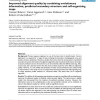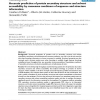6 search results - page 1 / 2 » Improved alignment quality by combining evolutionary informa... |
BMCBI
2006
13 years 7 months ago
2006
Background: Protein sequence alignment is one of the basic tools in bioinformatics. Correct alignments are required for a range of tasks including the derivation of phylogenetic t...
BMCBI
2007
13 years 7 months ago
2007
Background: Structural properties of proteins such as secondary structure and solvent accessibility contribute to three-dimensional structure prediction, not only in the ab initio...
ICASSP
2007
IEEE
14 years 1 months ago
2007
IEEE
Protein structure prediction aims to determine the three-dimensional structure of proteins form their amino acid sequences. When a protein does not have similarity (homology) to a...
CIKM
2009
Springer
14 years 2 months ago
2009
Springer
Background: Although both conservation and correlated mutation (CM) are important information reflecting the different sorts of context in multiple sequence alignment, most of ali...
IPPS
2006
IEEE
14 years 1 months ago
2006
IEEE
—Homology modeling requires an accurate alignment between a query sequence and its homologs with known three-dimensional (3D) information. Current structural modeling techniques ...


